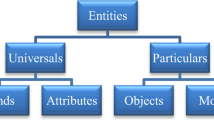Abstract
When building earth models, data heterogeneity is a major difficulty. Heterogeneity can be a consequence of different geologists’ views or goals when capturing the data, or can be a result of representing the geological models through distinct modeling languages. We analyze here how each one of these causes affect the way in which the geological information is captured into models and systems. The major claim of this paper is that many problems related to these heterogeneities can be solved or at least simplified by analyzing the models through the view of Ontology. We assume that heterogeneity is originally related to the different choices that a geologist makes, when she/he decides to consider a particular set of qualities among the large number of qualities that are attached to the entities that she/he intends to model. Considering this, for deciding which attributes hold the ontological nature of a given category of geological entity, one can apply the ontological notions of identity, rigidity, essentiality and unity. This allows solving the difficulties due to the heterogeneity of modeling languages by identifying, among the many entities and properties considered by the geologists, those that are eligible for being mapped from one model to another, not considering the name that they bear or the format in which they are represented. This paper also discusses how to build good models for further integration, avoiding some common misuse of hierarchical and partonomy relationships, and the limitations of the current available representation languages. Finally, we examine as a case study the “Petroleum system”, providing a concrete example for explaining how some issues related to data heterogeneity can be dealt with in practice.










Similar content being viewed by others
Notes
Minerals without a crystalline structure, such as opal, are no longer considered as minerals but are put in the category mineraloids.
code.google.com/p/ontouml/
References
Carbonera JL, Abel M, Scherer CMS (2015) Visual interpretation of events in petroleum exploration: an approach supported by well-founded ontologies. Expert Systems with applications 42:2749–2763
Chum F (2007) Use case: ontology-driven information integration and delivery - a survey of semantic web technology in the oil and gas industry
Cosentino L (2001) Integrated reservoir studies. Technip, Paris
Fanchi JR (2005) Principles of applied reservoir simulation. Elsevier
Feijó FJ (2010) Basics of petroleum geology (In portugues: Noções Básicas de Geologia de Petróleo). Petrobras University, Rio de Janeiro
Fiorini SR, Abel M, Carbonera JL (2015) Representation of part-whole similarity in Geology. Earth Science Informatics (Print), Springer
Fitting M, Mendelsohn RL (1998) First-order modal logic. Studies in epistemology logic, methodology, and philosophy of science, vol 277. Kluwer Academic Publishers
Gärdenfors P (2000) Conceptual spaces: the geometry of thought. MIT Press, Cambridge
Gruber TR (2003) Ontology progress—what is an ontology. Softw World 34:6
Guarino N (1994) In: Casati R, Smith B, White G (eds) The ontological level. Philosophy and the Cognitive Science Hölder-Pichler-Tempsky, Vienna, pp 443–456
Guarino N (1995) Formal ontology, conceptual analysis and knowledge representation. Int J Hum Comput Stud 43:625–640
Guarino N (1998) Formal ontology in information systems paper presented at the formal ontology in information systems. FOIS’98, Trento
Guarino N, Welty C (2002) Evaluating ontological Decisions with Ontoclean. Commun ACM 45:61–65
Guarino N, Welty C (2001) Identity and Subsumption. In: Green R, Bean CA, Myaeng SH (eds) The semantics of relationships. An interdisciplinary perspective. Information science and knowledge management, vol 3. Springer, Netherlands, pp 111–126. doi:10.1007/978-94-017-0073-3_7
Guarino N, Welty CA (2004) An overview of OntoClean. In: Staab S, Studer R (eds) Handbook of Ontologies. International handbook on information systems. Springer, Berlin, pp p 151–171
Guizzardi G (2005) Ontological foundations for structural conceptual models vol 05–74. CTIT PhD Thesis Series. Universal Press, Enschede, The Netherlands
Guizzardi G, Baiao F, Lopes M, Falbo RA (2010) The role of foundational ontologies for domain ontology engineering. Int J Inf Syst Model Des 1:22
Lorenzatti A, Abel M, Fiorini SR, Bernardes A, Scherer CMS (2011) Ontological primitives for visual knowledge. In: Costa ACR, Vicari R, Tonidandel F (eds) Lecture notes in artificial intelligence, vol 6404. São Bernardo do Campo: Springer Berlin / Heidelberg, pp 1–10
Ludäscher B, Lin K, Bowers S, Jaeger-Frank E, Brodaric B, Baru C (2006) Managing scientific data: from data integration to scientific workflows. Geological survey of America special paper 397
Magoon LB, Dow WG (1994) The petroleum system. In: Magoon LB, Dow WG (eds) The petroleum system: from source to trap, vol 60. AAPG Memoir. AAPG, Tulsa, pp 3–24
Perrin M, Rainaud J-F, Mastella LS, Abel M (2007) Knowledge related challenges for efficient Data fusion. Paper presented at the Data fusion: combining geological, geophysical and engineering data,SEG/AAPG/SPE Joint Workshop, Vancouver, October 14–18
Perrin M, Abel M (2013) Earth models as subsurface representations. In: Perrin M, Rainaud J-F (eds) Knowledge driven earth modelling. Editions Technip, Paris, pp 3–24
Werlang R, Abel M, Perrin M, Carbonera JL, Fiorini SR (2013) Ontological foundations for petroleum application modeling. Paper presented at the The Petroleum Network Education Conference, Houston
Zimmerman D (1996) Persistence and Presentism Philosophical Papers 25 115–126
Acknowledgments
We gratefully thank GEOSIRIS; Brazilian Research Council, CNPq; PRH PB-17 program (supported by PETROBRAS); and ENDEEPER Co. for the support to this work.
Author information
Authors and Affiliations
Corresponding author
Additional information
Communicated by: H. A. Babaie
Published in the Special Issue of Semantic e-Science with Guest Editors Dr. Xiaogang Ma, Dr. Peter Fox, Dr. Thomas Narock and Dr. Brian Wilson
Rights and permissions
About this article
Cite this article
Abel, M., Perrin, M. & Carbonera, J.L. Ontological analysis for information integration in geomodeling. Earth Sci Inform 8, 21–36 (2015). https://doi.org/10.1007/s12145-015-0211-9
Received:
Accepted:
Published:
Issue Date:
DOI: https://doi.org/10.1007/s12145-015-0211-9




